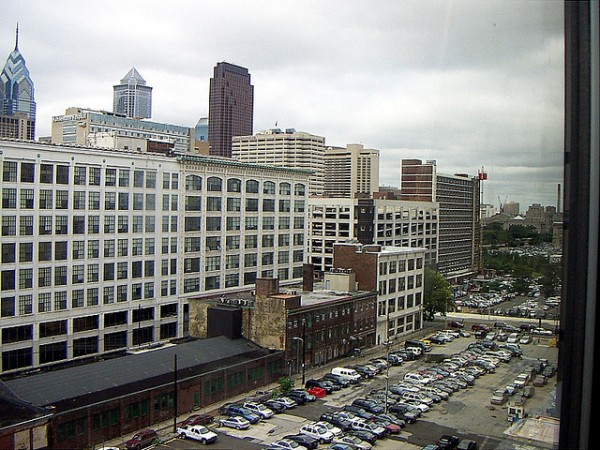Topic(s): Projects and Events
Why skyscrapers get a break under Philly’s stormwater pricing
October 4, 2013


Photo Credit: John Turner on Flickr
Cross-posted from Next City, this article is part of the 2013 Reclaiming Vacant Properties Conference liveblog series. Check out all the in-depth content — even if you weren’t able to join us in Philadelphia from September 9-11, 2013, you’ll feel like you did!
Many cities remain in denial about the high costs that low-density, impervious land uses like surface parking lots impose on water and sewer infrastructure. But Philadelphia, with its very old combined sewer systems, can’t afford denialism.
That’s why in 2010, the Philadelphia Water Department began charging higher stormwater fees to properties that generate the most runoff, and reducing fees on lower-impact properties like high-rise buildings. At a Wednesday panel called “Green and Blue Infrastructure,” the Water Departmen
t’s Jessica Noon explained how these incentives are supposed to work, and what property owners can do to reduce their bills.
Next City: Can you tell us about the stormwater pricing component of your strategy, where property owners with larger impermeable surfaces pay more?
Jessica Noon: We have all of the non-residential properties in the city, and residential condos over a certain size, pay for the impervious surface with a stormwater fee. Residential row-homes have a flat fee of about $13. And we have a four-year phase-in of the storm water fees.
Our rates aren’t actually increasing — we’re just rearranging and redistributing how the fees are paid. In the past, every parcel paid a stormwater fee based on its usage. If you had a large high-rise residential building, you’d have quite a large fee because you’d have a large residential water usage bill. Those high rises are now seeing their stormwater fees shrink because their impervious cover is actually quite small. It’s just their roof, whereas large malls with big parking lots had much smaller fees. Now they’re seeing huge fees based on their 10-acre parking lots.
But we also have a program where if site owners want to retrofit and install green infrastructure to manage their stormwater, then they can get credit to reduce their fees.
NC: What’s been the response to this new pricing strategy from property owners? Have you seen any behavioral changes yet?
Noon: Our fees aren’t high enough yet, but over the course of the phase-in they’ll be a lot higher for the properties with lots of impervious cover. That’s part of why the sites we’re targeting for improvements were selected: To encourage thinking about density and usage, and get developers and stakeholders thinking about impervious surfaces and how to reduce them.
NC: How do you expect this to affect future development choices?
Noon: For new development over 15,000 square feet, everybody has to manage all of their stormwater. So new development already gets those credits toward their stormwater fees, because they are responsible for managing their runoff.
Subscribe to join 14,000 community development leaders getting the latest resources from top experts on vacant property revitalization.
